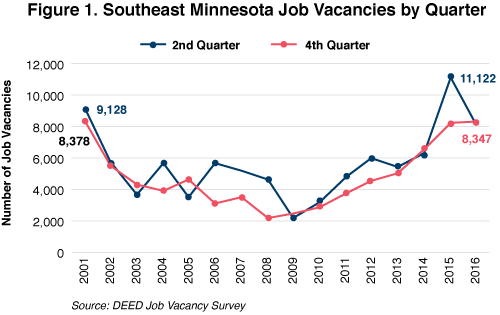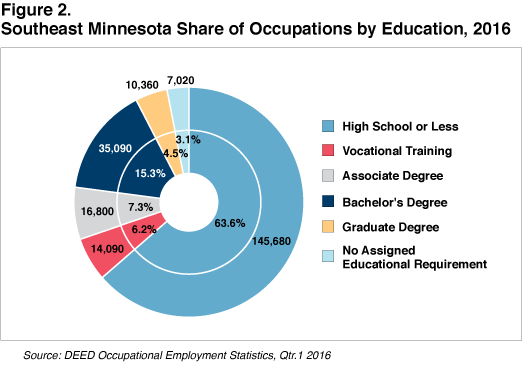
by Cameron Macht
June 2017
Southeast Minnesota had 8,350 job vacancies in the fourth quarter last year, returning to a level last seen in the early 2000s.
Southeast Minnesota's economy is expanding at a steady pace, with employers reporting just over 242,000 jobs through the third quarter of 2016. The 11-county region added nearly 3,000 jobs in the past year and more than 15,500 jobs since the bottom of the recession in 2009.
Covered employment in the region has increased by about 6.3 percent during the past 15 years, leading to record employment levels in 2016.
The labor force in Southeast Minnesota rose 5.6 percent from 2001 to 2016. At the same time, the number of unemployed workers in the region dropped below 10,000 in 2015 and 2016, less than half as many as in 2009 and the lowest since 2001, when there were just 9,125 unemployed workers.
This has created an extremely tight labor market in Southeast Minnesota, with just over one job seeker for every vacancy in the region. Local employers reported nearly 8,350 job vacancies in the fourth quarter of 2016, the fourth-highest number ever recorded in the region.
Current demand has returned to levels last reached in the early 2000s, creating the same kind of constraints for employers who wanted to add jobs but couldn't find enough available workers to fill them (see Figure 1).

Not surprisingly, health care and social assistance had the most vacancies in Southeast Minnesota. In fact, the industry accounted for over 25 percent of openings in 2016 and closer to one-third of all openings in the previous four years, demonstrating its critical importance to the regional economy.
The next largest number of vacancies was in accommodation and food services and in retail trade, which combined to offer about one-third of current job postings in the region. Well over half of these vacancies were part time, with median wage offers below $11 in both industries. While accommodation and food services added openings, retail trade saw a slight retreat in hiring activity in 2016.
The construction, manufacturing, information, and transportation and warehousing industries also reported fewer openings in 2016 than the previous year, while employers in the administrative support and waste management services and finance and insurance industries saw the biggest year-over-year gains in hiring demand.
Looking back further, just two industries – information and utilities – have fewer openings now than five years ago, while most doubled or tripled their number of vacancies compared with the fourth quarter of 2011, when the recovery was just taking hold (see Table 1).
| Southeast Minnesota Job Vacancy Survey Results, Qtr. 4 2016 | |||||||
|---|---|---|---|---|---|---|---|
| Industry | Number of Job Vacancies | Percent of Job Vacancies | Percent Part-Time | Requiring Post-Secondary Education | Requiring 1+ Years Experience | Median Wage Offer | Change in Vacancies Q4 2011 – Q4 2016 |
| Total, All Industries | 8,347 | 100.0% | 48% | 27% | 34% | $12.70 | 120.7% |
| Health Care and Social Assistance | 2,332 | 27.9% | 49% | 53% | 46% | $16.20 | 149.4% |
| Accommodation and Food Services | 1,896 | 22.7% | 54% | 2% | 13% | $10.31 | 467.7% |
| Retail Trade | 1,063 | 12.7% | 89% | 2% | 12% | $10.97 | 71.2% |
| Admin Support and Waste Mgmt. Services | 614 | 7.4% | 2% | 25% | 31% | $12.49 | 323.4% |
| Manufacturing | 568 | 6.8% | 2% | 36% | 47% | $15.75 | 81.5% |
| Educational Services | 391 | 4.7% | 53% | 65% | 46% | $15.21 | 8.3% |
| Other Services | 273 | 3.3% | 78% | 19% | 5% | $9.80 | 42.9% |
| Construction | 219 | 2.6% | 2% | 35% | 100% | $22.45 | 112.6% |
| Finance and Insurance | 202 | 2.4% | 84% | 5% | 91% | $14.12 | 137.6% |
| Public Administration | 172 | 2.1% | 54% | 36% | 31% | $12.36 | 160.6% |
| Wholesale Trade | 163 | 2.0% | 10% | 10% | 55% | $12.00 | 10.1% |
| Transportation and Warehousing | 139 | 1.7% | 36% | 13% | 34% | $16.96 | 321.2% |
| Management of Companies | 118 | 1.4% | 42% | 57% | 39% | $17.58 | 168.2% |
| Agriculture and Related | 107 | 1.3% | 49% | 0% | 49% | $12.02 | 78.3% |
| Information | 45 | 0.5% | 0% | 67% | 100% | $16.97 | -74.9% |
| Utilities | 3 | 0.0% | N/A | N/A | N/A | $28.47 | -75.0% |
| Source: DEED Job Vacancy Survey | |||||||
Over the past five years, only one-third of the job vacancies in Southeast Minnesota have required postsecondary education. Openings requiring that level of education fell to a low of just 27 percent in the fourth quarter of 2016.
Much of the drop was due to the region's industry mix. While over half of the job postings in health care and social assistance required postsecondary training, only 2 percent of the openings in accommodation and food services and in retail trade did.
Educational requirements were also consistently low in administrative support and waste management services (which includes personnel staffing agencies), construction, transportation and warehousing, and arts, entertainment and recreation. Other industries tended to have higher educational requirements, especially public administration, educational services, management of companies, utilities and information, where over half of all openings required postsecondary training.
Educational requirements and wage offers depended more on the occupation than the industry. For example, while both are in the same industry (health care and social assistance), the median wage offer for health care support occupations was $12.60 per hour, compared with a median wage offer of $25.82 for health care practitioners and technical occupations.
Likewise, wage offers for heavy and tractor-trailer truck drivers rose above $25 per hour in 2016, while wage offers for light truck and delivery services drivers dropped to $9.30 per hour.
Almost two-thirds of occupations in the region can be gained with a high school diploma or less and some amount of on-the-job-training. Based on data from DEED's Occupational Employment Statistics program and the state's new educational requirements for occupations table, 13.5 percent of jobs in Southeast Minnesota required vocational training or an associate degree. About 20 percent needed a bachelor's degree or higher (see Figure 2).

In fact, high school students would be qualified for four of the top five largest occupations in the region, with only registered nurses requiring postsecondary training.
Although many of these low-skill occupations, and some of the largest ones, pay relatively low wages compared with higher-skill occupations (see Table 2), more than 80 occupations requiring a high school diploma or less paid median wages above $20 per hour. This represents more than 22,300 jobs in Southeast Minnesota. Likewise, nearly 8,300 jobs that required only short-term vocational training paid more than $20 per hour at the median. This shows there are high-paying jobs found in every educational category.
| Largest Occupations by Educational Requirements in Southeast Minnesota | |||||
|---|---|---|---|---|---|
| Top 5 Occupations Requiring High School or Less | Estimated Employment | Median Wage | Top 5 Occupations With No Clear Educational Requirements | Estimated Employment | Median Wage |
| Retail Salespersons | 6,530 | $10.45 | Business Operations Specialists, All Other | 1,130 | $25.94 |
| Food Prep and Serving Workers | 4,960 | $9.07 | Sales Reps., Services, All Other | 730 | $27.62 |
| Cashiers | 4,870 | $9.50 | Managers, All Other | 570 | $45.42 |
| Office Clerks, General | 4,090 | $14.74 | Office and Administration Workers, All Other | 450 | $12.83 |
| Customer Service Representatives | 3,780 | $14.91 | Social Services Specialists, All Other | 320 | $19.20 |
| Top 5 Occupations Requiring Vocational Training | Estimated Employment | Median Wage | Top 5 Occupations Requiring Associate Degree | Estimated Employment | Median Wage |
| Nursing Assistants | 3,820 | $12.37 | Registered Nurses | 9,990 | $29.26 |
| Licensed Practical Nurses | 2,000 | $20.38 | Computer User Support Specialists | 870 | $22.92 |
| Machinists | 1,150 | $20.00 | Police and Sheriff's Patrol Officers | 850 | $26.14 |
| Electricians | 1,040 | $29.51 | Radiologic (X-Ray) Technologists | 770 | $32.44 |
| EMTs and Paramedics | 820 | $16.70 | Medical and Clinical Lab Technicians | 540 | $21.34 |
| Top 5 Occupations Requiring Bachelor's Degree | Estimated Employment | Median Wage | Top 5 Occupations Requiring Graduate Degree | Estimated Employment | Median Wage |
| Elementary School Teachers | 2,550 | $51,654 | Nurse Practitioners | 1,020 | $51.12 |
| General and Operations Managers | 2,480 | $35.41 | Pharmacists | 780 | $63.37 |
| Secondary School Teachers | 1,950 | $58,531 | Child/Family/School Social Workers | 610 | $27.58 |
| Medical and Clinical Lab Technologists | 1,280 | $32.30 | Physicians and Surgeons, All Other | 430 | >$100 |
| Accountants and Auditors | 1,240 | $27.59 | Lawyers | 400 | $36.56 |
| Source: DEED Occupational Employment Statistics, Qtr. 1 2016 | |||||
As employers in Southeast Minnesota continue to expand and look to fill their jobs with qualified applicants, data show that students and job seekers will find strong demand for occupations at every education level, ranging from a high school diploma or less to graduate degrees. Data and analysis of occupations and vacancies can help better align the regional workforce with employer demands.